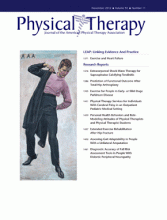Abstract
Background Gait adaptability, including the ability to avoid obstacles and to take visually guided steps, is essential for safe movement through a cluttered world. This aspect of walking ability is important for regaining independent mobility but is difficult to assess in clinical practice.
Objective The objective of this study was to investigate the validity of an instrumented treadmill with obstacles and stepping targets projected on the belt's surface for assessing prosthetic gait adaptability.
Design This was an observational study.
Methods A control group of people who were able bodied (n=12) and groups of people with transtibial (n=12) and transfemoral (n=12) amputations participated. Participants walked at a self-selected speed on an instrumented treadmill with projected visual obstacles and stepping targets. Gait adaptability was evaluated in terms of anticipatory and reactive obstacle avoidance performance (for obstacles presented 4 steps and 1 step ahead, respectively) and accuracy of stepping on regular and irregular patterns of stepping targets. In addition, several clinical tests were administered, including timed walking tests and reports of incidence of falls and fear of falling.
Results Obstacle avoidance performance and stepping accuracy were significantly lower in the groups with amputations than in the control group. Anticipatory obstacle avoidance performance was moderately correlated with timed walking test scores. Reactive obstacle avoidance performance and stepping accuracy performance were not related to timed walking tests. Gait adaptability scores did not differ in groups stratified by incidence of falls or fear of falling.
Limitations Because gait adaptability was affected by walking speed, differences in self-selected walking speed may have diminished differences in gait adaptability between groups.
Conclusions Gait adaptability can be validly assessed by use of an instrumented treadmill with a projected visual context. When walking speed is taken into account, this assessment provides unique, quantitative information about walking ability in people with a lower-limb amputation.
Footnotes
All authors provided concept/idea/research design, writing, and consultation (including review of manuscript before submission). Mrs van Ooijen and Mr Kraal provided data collection. Mrs van Ooijen, Mr Kraal, Dr Houdijk, and Dr Roerdink provided data analysis. Dr Houdijk and Dr Roerdink provided project management and fund procurement. Mr Wiggerts and Mr Polomski provided study participants and institutional liaisons. Dr Houdijk and Dr Janssen provided facilities/equipment. The contributions of Irene Derksen, Marcia Teunissen, and Otelie Bosboom in selecting and including participants are gratefully acknowledged. The authors thank Bert Coolen for developing and implementing the software for movement-dependent presentation of obstacles and regular and irregular patterns of stepping targets.
This study was approved by the Medical Ethical Review Board, VU University Medical Centre, Amsterdam, the Netherlands.
This study was supported by a grant from the OIM Foundation, Assen, the Netherlands. The contribution of Dr Roerdink was supported by Veni Grant 451-09-024 from the Netherlands Organization for Scientific Research (NWO).
- Received October 25, 2011.
- Accepted July 23, 2012.












